|
Malta
Planning
Robbie Burns said `The best laid plans of mice and men aft
gang aglee`.
That aptly describes planning for this trip. Originally we had
planned four days in Malta, five each in Sicily and Sardinia (where we would
meet my cousin Nicholas and his wife Patricia), then 12 days in Bulgaria. Son
Tom was to join us up to the flight to Bulgaria, then return to the USA. Then an
unexpected infection from China, known as the coronavirus, hit the world. Son
Tom was told by Rice University that if he went to Italy, where the virus had
been particularly rampant, he would have to self quarantine for 14 days upon his
return. Very stressful and hurried change of plans ensued, dropping Sicily and
Sardinia and having Tom join us for the entire trip, which meant Malta and
Bulgaria.
Lesson learned about trip insurance: unless you buy
super-expensive trip insurance to cover cancel for any reason, the policy will
not cover cancellations even when the State Department advises to avoid
non-essential travel or issues a “Do not travel" warning. So, DO NOT
BUY travel insurance!!!
With the help of the travel agent who made our airfare
arrangements, the travel agent in Bulgaria who made all of our arrangements in
Bulgaria and Tom cancelling ferries, car rentals and other arrangements we were
able to move our trip around and depart for Malta on time, but shortening our
trip by 10 days. So, on to the adventure.
March 4, 2020
We flew from DFW to LHR on American Airlines in premium
economy, which is somewhat better than steerage, but only marginally.
March 5, 2020
We had a few hours layover in
LHR then flew to Malta on Air Malta. The seating was so tight that Tom's knees
jammed against the back of the seat in front. Air Malta proudly says they were
voted the fifth best regional airline in Europe, but that is faint praise. The
flight attendants looked like they were all from the same family, same hairdos,
expressions, makeup and a certain amount of surliness. We weren’t impressed
except we landed on time after a safe flight.
We were met by a driver we had hired and she took us to our
apartment near St. Paul’s Bay, a town called Qawra, put that in your spell
checker. The host met us and showed us about. The apartment is spacious, but
cold as it is still winter and we didn’t figure out the ductless heat pump until
our final night.
We had dinner at a nearby restaurant, il Giardino, and it was
quite nice. Best was being able to speak with the server, a very lively and
lovely woman from Milano who was willing to switch back and forth between
Italian and English. Back to the apartment and crashed, we were very tired.
March 6, 2020
The Malta Classic Car Museum is just around the corner from
the apartment, so we had breakfast at the restaurant adjacent and then spent
some time poking around the museum. The cars are beautifully restored, but no
Morgans!
We took public transport into Valletta as we had tickets to
the Hypogeum. I can’t say that the public transport is the most well run we’ve
ever encountered as the drivers really aren’t helpful, partly because many don’t
speak English, even though it is an official language of Malta. I doubt they
speak Maltese either. We finally had to hire a cab to take us from the
Valletta central bus terminal to the Hypogeum.
The site was discovered quite by accident in the 1920s when
water lines were being installed. Best guess is that the site was developed
about 6000 BC. The architecture is quite amazing and one finds it hard to
believe that such a complex site could have been developed using primitive
tools, as it was created in the Stone Age.
The site was excavated by Sir Themistocles Zammit. He became
Malta`s first director of museums and we learned as we went through other sites,
was responsible for many other important excavations.
A very long walk from the Hypogeum to the Malta at War Museum,
which is about WWII. It is a small, but well done museum, with extensive under
ground shelters used during the siege. Starvation was only a few days away from
the residents, they must have suffered terribly. Fortunately they didn’t seem to
have the horrors of a German invasion and all that entailed.
We took public transport back to our apartment, it was a slow
trip because of the traffic and dozens of roundabouts. We decided to have dinner
again at Il Giardino as we like the place and it is close to the apartment.
March 7, 2020
Before we left home we made arrangements for a car and driver
for a full day of sightseeing. Malta isn’t large, but it is historically rich,
with evidence of habitation dating back 8000 years. It has been overrun by
Phoenicians, Romans, Arabs, Turks, Normans, French, Spanish, English and
Italians. What a varied history.
Our first stop was the incredibly beautiful town of Mdina,
perched on the highest point on the island. It was the original capital of
Malta, and had been much larger at one point, but the Arabs concentrated the
town to make it easier to defend. The architecture is beautiful, as the
buildings in the old town are all built of the warm sandstone quarried on the
island.

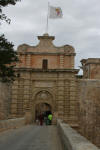
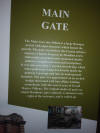

 The entrance to Mdina, a plaque about
the main gate and a building near tourist information
The entrance to Mdina, a plaque about
the main gate and a building near tourist information
The highlight was stepping into the cathedral and being lucky enough to
find a rehearsal, we assume for a concert, of a trumpeter and organist. The
acoustics in the cathedral are excellent, the two musicians superb.


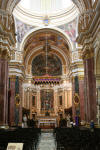 Exterior and interior of St. Paul's
Cathedral - note the trumpeter in the lower left
Exterior and interior of St. Paul's
Cathedral - note the trumpeter in the lower left
The
cathedral itself is beautiful with gorgeous marble floors and many frescos. The
cathedral was built on the site of the former Norman cathedral, which had been
damaged by an earthquake in 1693. The new cathedral was consecrated in 1703,
which seems quite amazing that it could have been built in such a short time.
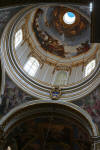
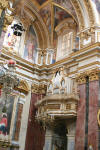 We never did see the organist
We never did see the organist

St. Paul was shipwrecked on Malta and there are several
churches on Malta named after him.
We wandered around the town a bit, but we had a full day
ahead, so couldn’t spend as much time as we would have liked.
Our next stop was Rabat, another old town roughly adjacent to
Mdina. While not as beautiful as Mdina (which son Tom found out means `city`) it
still had beautiful buildings. We went into St. Paul`s Grotto, where it is
believed he founded the first Christian community in 60 AD. In the same complex
are extensive catacombs and WWII shelters.
 St. Paul's Church in Rabat
St. Paul's Church in Rabat
We returned to Mdina to take in the Villa Romana. It is quite
small, but the mosaics that were uncovered during the excavations were quite
lovely. One mosaic in particular was interesting in that there had been some
repairs at one time, but the materials used were somewhat inferior to the
original material. Archeologists speculate that the family had been hit with
reduced financial circumstances. This was another site excavated by Zammit.

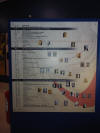 The mosaic and Roman influence timeline
The mosaic and Roman influence timeline
Our driver, Michael, who is Maltese so knows his way around,
dropped us off at a restaurant for lunch. Service was rather slow; the poor
waitress was running ragged. However, lunch was acceptable, so no complaints.
Michael drove us next to Hagar Qim and Mnajdra, both temples from about 5700
years ago. Both are World Heritage sites. Hagar Qim is under a protective
awning as the sandstone is quite fragile. The wind was very strong and cold, so
we didn’t want to walk ½ kilometer to Mnajdra.

 Temple at Hagar Qim - pronounced Hajar
Im
Temple at Hagar Qim - pronounced Hajar
Im
Zammit was involved in the excavation of these sites as well.
Michael drove us to the Blue Grotto, but there wasn’t much to
see from the cliff above.

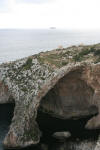
 The Blue Grotto and Filfla island
The Blue Grotto and Filfla island
He then drove us to the fishing village of Marsaxlokk,
which some lovely old traditional fishing boats in the harbor. Sadly, there are
few of these boats remaining and new ones are not being built.

 The fishing boats and a sculpture of a
fisherman
The fishing boats and a sculpture of a
fisherman
There is a very large ship docked across the harbor from the
village and the deck has enormous bladders which Michael told us contained gas
from Russia. It was docked next to the power plant, used to fuel same.
 The LNG tanker
The LNG tanker
 A Malta landscape
A Malta landscape
Returned to our apartment to do laundry and pack. We learned
more about electricity in Malta. We have an electricity allowance and about 11
PM the electricity went out, plunging us into darkness. We put a two euro coin
in the meter, but it only gave us a few more hours of electricity. Most
unpleasant as it was cold.
Dinner at a different Italian restaurant, Il Sorpresso, which
was fine, though not as good as Il Giardino. Plenty of food, more than we could
eat, but not as well prepared and tasty, as Cassidy would say.
March 8, 2020
Last day in Malta Michael picked us up at 10AM as planned and
drove us to Valletta. We left our luggage at the British Suites Hotel where we
had reservations and climbed the steps to the beautiful Upper Barrakka Garden.
The view of the harbor was wonderful, but we were challenged to name the three
cities on the opposite side of the harbor.

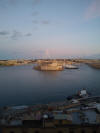
 The harbor at Valletta
The harbor at Valletta
 The battery overlooking the harbor
The battery overlooking the harbor
We strolled into the center of town and went into the National
Archeological Museum. There are displayed many artifacts from the temples that
we saw yesterday, as well as artifacts from the Bronze Age and Phoenician
periods. It is common for the museums to have free audio guides, which typically
are very well done. The museum itself is showing some signs of age, as the
building is about 300 years old, but it was a worthwhile experience.
It was a Sunday and, despite there now being three cases of
the coronavirus in Malta, the city center, which is primarily traffic free, was
busy with tourists and shoppers. The cathedral was closed, which may be normal,
although churches in Italy have been closed because of the virus.
We had a rather indifferent lunch at a restaurant in the area,
then Tom left son Tom and me to explore some more while he went to the hotel to
prepare for departure the morning.
Tom and I went to the Armory, which housed a collection of
armaments and various pieces of arms, many dating from the time when the Knights
of St John defended Malta against the Turks in 1565.
Tom and I walked back to the hotel, a little confused because
the streets aren’t always through streets or even on one level.
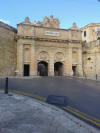 The Victoria Gate
The Victoria Gate
We had dinner in the hotel since we have a very early flight
to Sofia by way of Vienna tomorrow. Our waiter was from Siracusa in Sicily. He
thought that Texas was part of California. The maitre d' was Bosnian but had
traveled all over the world whilst working for cruise lines before settling in
Malta.
|